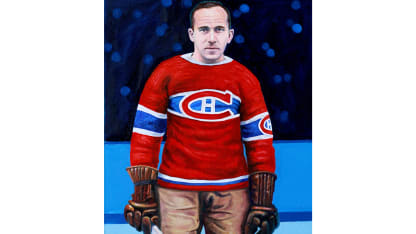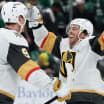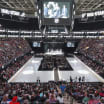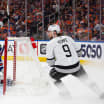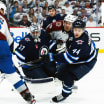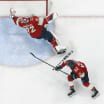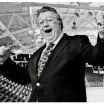As part of the NHL Centennial Celebration, renowned Canadian artist Tony Harris will paint original portraits of each of the 100 Greatest NHL Players presented by Molson Canadian as chosen by a Blue Ribbon panel. NHL.com is unveiling two portraits each day this week.
Today, the portraits of forwards Bernie "Boom Boom" Geoffrion and Howie Morenz are unveiled in the 48th installment.
Geoffrion, Morenz portraits unveiled
Color paintings of 100 Greatest NHL Players will be revealed on NHL.com during 2017
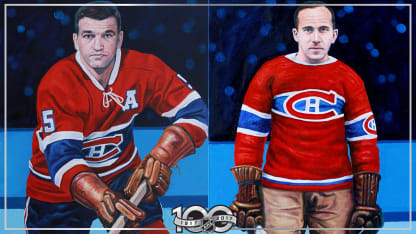
By
NHL.com @NHLdotcom
Bernie Geoffrion, perhaps better known as Boom Boom, is among the few players in NHL history who changed the game. He had more to do with popularizing the slap shot than anyone.
In an era when goalies didn't wear masks, the sight of Geoffrion cranking up his slap shot could be terrifying. As defenseman and longtime Montreal Canadiens teammate Dollard St. Laurent noted, "He changed the game with the slap shot. Goalies were afraid to face him. He's the reason goalies started wearing masks."
The Montreal native grew up like most other kids in the region, idolizing the Canadiens and Maurice "Rocket" Richard in particular. By 1950-51, the two were teammates. One year later, Geoffrion was a 30-goal scorer.
He won the NHL scoring championship in 1954-55, edging Richard by a point after the Rocket was suspended for the final three games of the season for punching an official after a stick-swinging incident. Geoffrion won the Art Ross Trophy again in 1960-61, when he tied Richard's NHL record of 50 goals in a season.
Geoffrion was a member of six Stanley Cup-winning teams before he retired from the Canadiens after the 1963-64 season. But in 1966, he returned with the New York Rangers and helped them advance to the Stanley Cup Playoffs twice before retiring for good with 393 goals. Geoffrion later coached the Rangers, the Atlanta Flames and the Canadiens, although he walked away from what he thought would be a dream job with his former team after 30 games in 1979-80.
He was inducted into the Hockey Hall of Fame in 1972.
In his NHL100 profile of Geoffrion
, author Wayne Coffey recounted the circumstances surrounding his scoring titles:
"With the Canadiens needing to win their two remaining games to secure first place, Geoffrion was in an impossible spot, his team needing him to score, and fans openly rooting for Richard to hold on to the scoring title. In an interview with the Hockey Hall of Fame, Geoffrion said, 'Doug Harvey told me, 'Listen, we came to win first place. You've got to score goals to help us win.' I said, 'You put the puck on my stick and if I have a chance to score, I don't care who I have to surpass. I get paid to play and score goals.'
"Geoffrion had a goal and two assists in the next game, and went on to win the scoring title. Many Canadiens fans were furious that he'd 'stolen' the Art Ross Trophy from Richard, and were slow to forgive him for that.
"'I can assure you that I had more heartbreak in winning the trophy than Richard had in missing it,' Geoffrion said. 'The Rocket never held a grudge against me. It wasn't my fault that Rocket got suspended.'
"Geoffrion had his most prolific season in 1960-61, when he won the scoring title with 95 points and dueled with the Toronto Maple Leafs' Frank Mahovlich for the most goals right down to the final games of the season. Geoffrion moved ahead, scoring his 49th goal against the Blackhawks, before the Canadiens faced the Maple Leafs at the Forum. Teammate Gilles Tremblay beat Toronto's Bob Pulford to the puck in the corner and passed it back to Geoffrion, who fired a slap shot -- what else? -- past Maple Leafs goaltender Cesare Maniago.
"The goal, at 14:15 of the third period, made Geoffrion the first player besides Richard to hit the 50-goal mark, and resulted in a standing ovation from Canadiens fans.
"All, finally, was forgiven."
Artist Tony Harris said painting Geoffrion showed off some of the subtle changes in the Canadiens uniform during the years.
"While I was working on Boom Boom Geoffrion's portrait I noticed how subtly different the Canadiens' uniforms were from decade to decade, in particular the placement of the number on the sleeve (above the strip on the arm) and the width of the iconic blue-and-white band around the middle," he said. "The configuration of this particular setup might be my favorite."
Geoffrion and Howie Morenz had more in common than being Hockey Hall of Fame members who played for the Canadiens. Geoffrion married Morenz's daughter Marlene.
Morenz was the NHL's first superstar, the kind of player who brought fans out of their seats. In an era when one-man rushes were the order of the day, no one in his era was faster or more dynamic than Morenz.
But for a long time, Morenz had no interest in becoming an NHL star. He had a steady job in the same railroad machine shop where his dad worked and hockey was simply a way to make a few extra bucks. He turned down an offer of $1,000 from the Toronto St. Patricks (now the Maple Leafs) to play the final five games of the 1922-23 season, believing he wasn't fast enough or big enough to keep up with NHL players. The Canadiens kept pushing, and his father finally signed a contract (young Howie had yet to turn 21), but Morenz still had misgivings. He finally agreed to give the pros a try.
The speedy center was an instant sensation, scoring 13 goals in 24 games to help the Canadiens win the Stanley Cup in 1924, and was one of the League's most feared scorers for the next decade. But he was slowing down by 1934, when the Canadiens sent him to the Chicago Blackhawks; they traded him to the New York Rangers midway through the 1935-36 season. But with the Forum awash in empty seats and the Canadiens struggling, management brought him back to Montreal in 1937. Morenz, now 34, was past his prime, but he showed flashes of his old form and helped the Canadiens go 17-9-3 after 29 games.
However, Morenz's next game would be his last. On Jan. 28, 1937, his right leg was shattered in four places as the result of a collision with Chicago defenseman Earl Siebert. He was hospitalized and doctors told him he would never play again. He was still in the hospital when he died of a pulmonary embolism on March 8, 1937.
His funeral was held three days later; more than 50,000 fans filed past the casket, which was laid at center ice at the Forum. He was one of the first inductees of the Hockey Hall of Fame.
In his NHL100 profile of Morenz
, Coffey wrote about how the future "Stratford Streak" dodged piano classes to play hockey:
"Born in Mitchell, Ontario, on Sept. 21, 1902, Morenz was the youngest of three brothers, a boy who manifested his love of hockey from an early age, even if his mother had different ideas. Mrs. Morenz saw how smitten her two older boys were with hockey and was determined to have Howie learn to play the piano. Lessons were arranged for Saturday mornings.
"Unbeknownst to Mrs. Morenz, her son had to cross the Thames River to get to the piano teacher's house. The Thames is where Howie learned to skate, in hand-me-down skates that were so big he had to stuff wads of newspaper in the toes to make them fit. The temptation was too much. Howie stashed his skates at a friend's house, and every Saturday he would dutifully leave for his lesson, pick up his skates and spend the hour on the Thames and not a piano bench.
"When he returned home, he diligently practiced the one piano piece he knew so his mother wouldn't get suspicious. After some weeks passed, Mrs. Morenz called to check in with the teacher, eager to see how her son was progressing and to ask when the teacher planned to introduce other pieces for Howard to play.
"'Who's Howard?' the teacher asked."
Painting Morenz, who died 80 years ago, presented some hurdles for Harris.
"My main challenge in painting Howie Morenz was to bring a very dated black-and-white photograph to life," he said. "One aspect that was particularly interesting was the texture of his sweater. In the end, I was very pleased with the painting."
Bernie "Boom Boom" Geoffrion
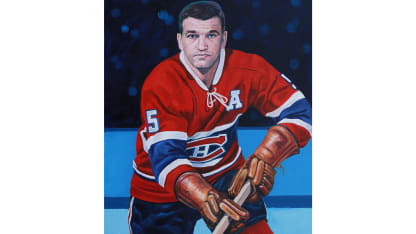
Howie Morenz
